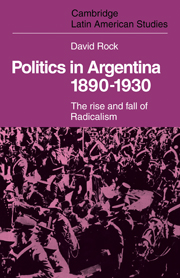Book contents
- Frontmatter
- Contents
- Preface
- 1 The components of Argentine society, 1890–1914
- 2 The oligarchy and institutional reform, 1880–1916
- 3 The rise of Radicalism, 1891–1916
- 4 The workers and their politics in Buenos Aires, 1890–1916
- 5 The first Radical government, 1916–22
- 6 The strikes, 1916–18
- 7 The Semana Trágica
- 8 1919
- 9 Postscript to the first presidency, 1920–2
- 10 The Alvear interlude, 1922–8
- 11 Yrigoyen's second presidency, 1928–30
- 12 Perspectives
- APPENDIXES
- 1 The occupational and class structure of the male population of the city of Buenos Aires by nationality, 1914
- 2 The rise of Radicalism – an historiographical note
- 3 The first Radical government and the Argentine Rural Society
- 4 The working class vote for the Radical and yrigoyenista parties in selected areas of Buenos Aires, 1912–30
- Select bibliography
- Index
11 - Yrigoyen's second presidency, 1928–30
Published online by Cambridge University Press: 04 August 2010
- Frontmatter
- Contents
- Preface
- 1 The components of Argentine society, 1890–1914
- 2 The oligarchy and institutional reform, 1880–1916
- 3 The rise of Radicalism, 1891–1916
- 4 The workers and their politics in Buenos Aires, 1890–1916
- 5 The first Radical government, 1916–22
- 6 The strikes, 1916–18
- 7 The Semana Trágica
- 8 1919
- 9 Postscript to the first presidency, 1920–2
- 10 The Alvear interlude, 1922–8
- 11 Yrigoyen's second presidency, 1928–30
- 12 Perspectives
- APPENDIXES
- 1 The occupational and class structure of the male population of the city of Buenos Aires by nationality, 1914
- 2 The rise of Radicalism – an historiographical note
- 3 The first Radical government and the Argentine Rural Society
- 4 The working class vote for the Radical and yrigoyenista parties in selected areas of Buenos Aires, 1912–30
- Select bibliography
- Index
Summary
The presidential elections of 1928 were Yrigoyen's greatest personal triumph. Yet within less than two years, on 6 September 1930 he was ignominiously overthrown by a military coup d'état. The crowds in Buenos Aires which had given him such fervent support in 1928, now ransacked his house and, for a time at least, acclaimed the new revolutionary government. The situation which developed in 1930 was thus in some respects similar to that in 1919. The government's popular support suddenly drained away and shifted towards new structures of mass organisation. As in 1919, too, these were led by the army, with the conservative elite in close attendance. Another common feature between the two years was the temporary character of the shift. By 1920 the Radicals had recovered sufficiently from the threat posed by the Patriotic League to win a strong majority in the congressional elections held that year. In 1931 the same occurred when they won the election for governor in the province of Buenos Aires. The difference was that in 1919 Yrigoyen had managed to forestall a coup d'état, whereas in 1930 he failed completely.
The composition and policies of the new government
In 1928, as a result of the party split of 1924 and the failure to reach agreement with Alvear, yrigoyenista Radicalism pivoted more closely than ever before on the support of the urban middle class groups.
- Type
- Chapter
- Information
- Politics in Argentina, 1890–1930The Rise and Fall of Radicalism, pp. 241 - 264Publisher: Cambridge University PressPrint publication year: 1975

